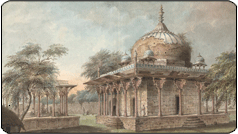Nadan Mahal Tomb (Shiekh Abdul Rahim Binori)
Earlier, Lucknow was a small town and only noteworthy structures of the earlier period extant today are the Alamgir mosque built by Aurangzeb [according to the Gazetteer of 1877-78] and the tombs of Nadan Mahal which belong to the period of Moghul Emperor Akbar (16th century), which are the oldest surviving monuments in Lucknow.
Nadan Mahal is situated in the old city in a park on the main road named as Nadan Mahal road which connects Nakhhas to Rakab gunj.The park had three structures and two of these are enclosed tombs.
One of the enclosed tombs towards east, contains the mortal remains of Sheikh Ibrahim, a Sufi saint of the Chishtia order. According to one account, he arrived during the time of Lodhi Kings. He expired in 961 Hijri (1553-54) during the reign of Humayun. He was a pious man who is revered even today. It is said that his tomb came to be known as 'Nidan' Mahal since the Sheikh's followers prayed for nidan (deliverance) at his tomb.
There is a large stone tablet at the entrance of his tomb which has three Persian couplets carved out in Nastaliq style that speak of the greatness of the saint. [The last line of the lyrical inscription gives the chronogram for the year of death of the saint as 961 Hijri]. "
The other enclosed tomb has a square chamber surrounded with corridors on all its four sides which have carved pillars and brackets in stone [that support the overhanging inclined stone slabs fixed for providing shade]. Besides some other graves, it contains in the centre, the marble cenotaph of Sheikh Abdur Rahim, a great favourite of Emperor Akbar, who owed his throne to him. Abul Fazl (the historian of Akbar's court) has mentioned him among the grandees of the Empire in Ain-e-Akbari.
Sheikh Mohammed Azmat Ali Naami Kakorvi in his historical account Murraqa-e-Khusraviwritten in 1282 Hijri (1866) tells the story of Sheikh Abdur Rahim, throwing light on his importance for Akbar. Astrologers had warned Akbar that two particular days were inauspicious for him as Emperor and he should let some reliable person occupy the throne for those two days. Akbar thus made Sheikh Abdur Rahim Emperor for two days. Just a few seconds before the inauspicious period was to end, the eunuch carrying Akbars imperial robes dropped down dead. A poisonous cobra was found among the Emperor's robes.
For his role, Sheikh Abdur Rahim was rewarded with lands of the pargana of Lucknow, Koraj and some parts of Bahraich. He is believed to have built a five storeyed palace for his sons called Panch Mahala and a fort called Machchhi Bhawan for himself, on the banks of river Gomti.
According to Abul Fazl, Sheikh Abdur Rahim had a wife, a Brahmin woman by the name of Krishna. After the death of her husband, she spent a vast amount restructuring the garden around the tomb. She herself saw to it that no weary wayfarer passed by unattended.
Adjacent to the tomb of Abdur Rahim, between the two domed enclosed tombs, there is a canopied pavilion supported by pillars fashioned in stone [which is called solah khamba for being a sixteen pillared structure]. There are some unmarked graves placed in this structure.
The Nadan Mahal tombs are excellent examples of buildings fashioned in the pre-Moghul [Afghan] style in stone. They are a rare sight in these parts because the later buildings were mostly made of brick and lime, using stucco for beautification. The structures appear to have blue tiles for a border on the top, but most of this is damaged beyond repair.
Source:
Hindustan Times, City Scan, A Time in History
Wednesday 2.7.1997 — Haunting Images of the past

